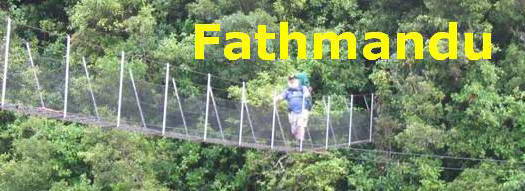Blechnum novae-zelandiae T.C.Chambers et P.A.Farrant (Blechnaceae)
Kiokio, Korokio, Horokio, Koropui, Piupiu, Tupari, Uruuru
whenua, Palmleaf Fern
Derivation: Blechnum from Greek 'blekhnon', the name of a fern; novae-zelandiae = of New Zealand
Synonyms
The above is the presently (1998) accepted name for the kiokio.
B. capense sensu Allan was demonstrated to have been preceded by B. capense Burm f., and hence illegitimate, and in any case possibly referring to more than one taxon in New Zealand. See below. For a period, the name B. procerum was used for this complex, but a 1998 review by Chambers and Farrant subdivided the complex into several species.
As the list of synonyms below demonstrates, apart from illegitimate names, there has been much debate about the nature of the different generic and family relationships inside this group.
Stegania procera var. stipulosa A.Rich.;
Blechnum capense sensu Cheeseman;
Lomaria capensis sensu Cheeseman;
Lomaria procera var. flagelliformis Szyszyl;
Osmunda capensis, L. Mantissa 1771, 306.
Omunda procera Forst. f. Prodr. 1786, 78.
Onoclea procera (Forst.f.) Spreng. in Schrad. Journ. Bot. (1799) 2, 1799, 267
Blechnum procerum (Forst. f.) Swartz Syn. Fil. 1806, 115;
Lomaria capensis (L.) Willd. Sp. Pl. 5, 1810, 291;
Stegania procera R.Br. Prodr. 1810, 153;
Blechnum. capense (L.) Schlecht. Adumb. Fil. Bonae Spei. 1825, 34, t. 18.
Lomaria procera Spreng. Syst. Veg. 4, 1827, 65;
Lomaria latifolia Col. in Tasm. J. Nat. Sci. 2, 1846, 175;
Lomaria duplicata Potts in T.N.Z.I. 9, 1877, 491
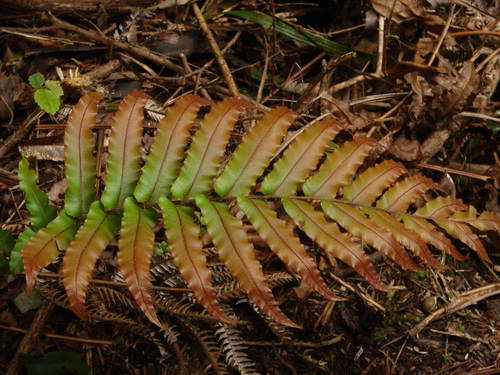
Anderson Track, Waitakeres
The red coloration is a protection against strong light. It's close relatgion, B. montanum, the Mountain Kiokio, found mainly in the South Island, tends to feature this coloration more generally.
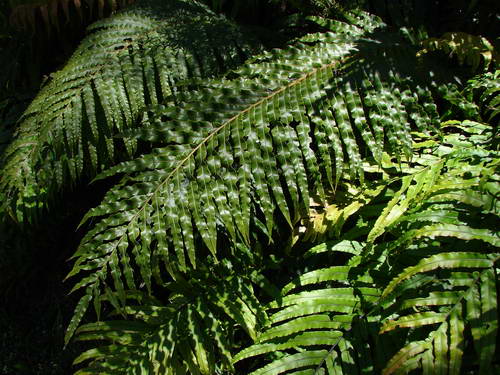
6 December 2006, Pipeline Road, Waitakeres
At their largest, these fronds can be up to 3m long.
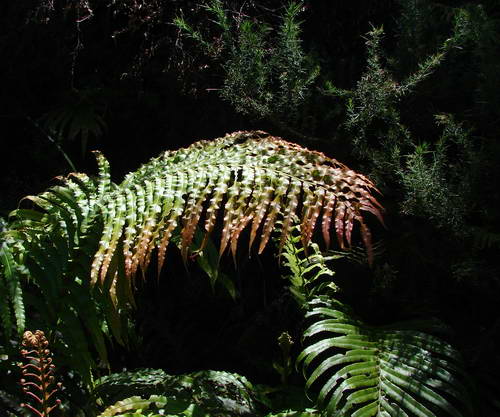
6 December 2006 Pipeline Road, Waitakeres
Lurking in the back right of the picture is another principal component of roadside scrub
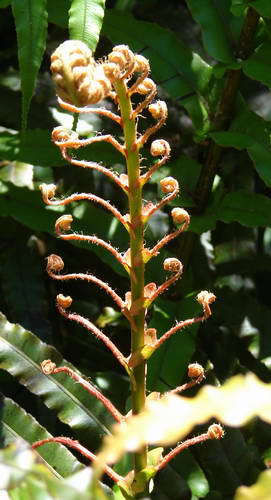
6 December 2006, Pipeline Road, Waitakeres
It's a prominent feature along any track with a decent amount of moisture and an extra dose of light - the edges of the road along the Scenic Drive are covered with it.
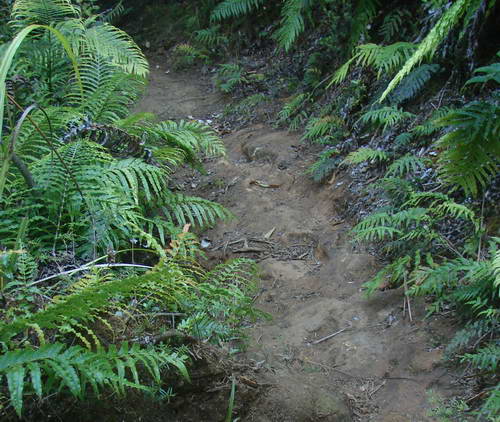
5 January 2007, Winstone Track, Piha

9 January 2007, Long Road Track, Waitakeres
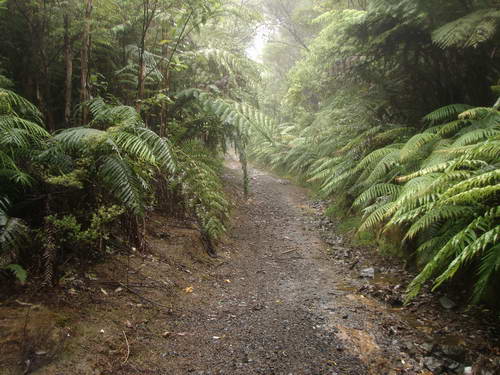
9 January 2007, Long Road Track, Waitakeres
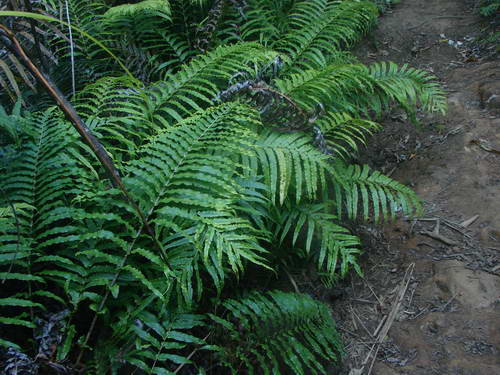
5 January, 2007, Winstone Track, Piha
As Brownsey et al remark in a 1985 article:
Our concepts of families and genera are also
changing and in the twenty or more years since
Allan's work [NZ Flora] there have been major revisions of
such families as Hymenophyllaceae (Morton 1968),
Cyatheaceae (Tryon 1970), and Thelypteridaceae
(Holttum 1971) as well as generic revisions of Lastreopsis
(Tindale 1965), Doodia (Partis 1972), Tmesipteris
(Chinnock 1975), Grammitis (Parris &
Given 1976), Lindsaea (Kramer & Tindale 1976),
Asplenium (Brownsey 1977a, b), Deparia (Kato
1984), and Hypolepis (Brownsey & Chinnock 1984).
These, together with other smaller revisions, additions
of new species, and sundry nomenclatural
changes, have resulted in a situation where a high
proportion of the names used by Allan (1961) are
out of date. (My emphasis. DCW)
He goes on to say:
Blechnum is an extremely important genus in
New Zealand, being second only to Hymenophyllum
in terms of the number of species. A cytotaxonomic
investigation of the local representatives
was the subject of an M.Sc. thesis by Chambers,
Brownsey et al. — Classification of New Zealand pteridophytes 445
(1954) — which is slowly expanding into a world-wide
monograph. Recently Given (in prep.) has suggested
that the Blechnum capense aggregate, long
recognised as exceedingly polymorphic, comprises
five New Zealand taxa, with close relatives in Australia
and South Africa.
Despite the fact that some
of these taxa are amongst the most common ferns
in New Zealand, only two have legitimate names
at present. The name B. capense (L.) Schldl., previously
used for the best known of these taxa, is
predated by B. capense Burm. f. but, in any case,
is now known to apply only to South African
material; New Zealand plants once referred to this
species require a different name.
They include two
forms. One ("black spot") is characterised by large
fronds with numerous pairs of pinnae which
decrease markedly in length towards the base of
the frond, and stipe scales with an obvious black
centre; this form occurs in a wide variety of habitats
but especially on road banks and cliff sides
(Crookes 1963, p. 312).
The other ("mountain") has
a more truncate base to the frond and bronze
coloured pinnae with undulate margins, and occurs
primarily in mountain regions of the South Island
(Crookes 1963, p. 285).
Plants with fronds similar
to "black spot" in outline but smaller in size, with
uniformly pale brown stipe scales, and with more
distant, thin textured, obtuse pinnae, occur in
swamps and other damp habitats; these are referable
to the Australian species, B. minus (Crookes
1963, p. 283 — as B. capense "swamp form").
The
name B. minus has been used incorrectly in New
Zealand by Allan (1961) and others for a plant
which should be called B. procerum. This is closely
related to the Australian B. wattsii Tindale (1963b),
and has relatively few pairs of more or less equally
sized, short, broad pinnae with rounded apices; it
occurs most commonly on forest floors (Crookes
1963, p. 281 — as B. minus.)
The morphological
characteristics of these forms have also been well
illustrated recently by Molloy (1983).
The fifth
taxon commonly known as the "Green Bay form"
(Crookes 1963, p. 287) occurs in steep-sided gullies
and cliffs, often in coastal habitats; it has frond
dimensions comparable to "black spot", but is deltoid
in outline with a long, thick stipe and numerous
pairs of pinnae which decrease in length towards
the apex of the frond.
In 1998, Chambers and Tarrant revisited this complex: The abstract of their article is as follows:
There are four species of Blechnum in
the B. procerum complex in New Zealand : B.
procerum and three new species, B. novae-zelandiae,
B. montanum, and B. triangularifolium . All three are
distinct from the Australian B. minus . The new species
are endemic to New Zealand and have been
known as "Kiokio", "Mountain Kiokio", and "Green
Bay Kiokio", respectively, and variously but inconsistently
referred to as B. capense, B. procerum, B.
minor, B. minus, and Lomaria latifolia.
|
